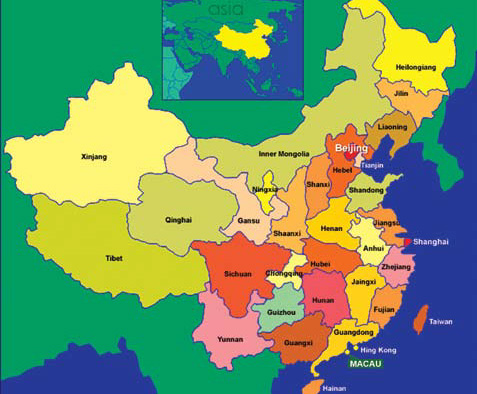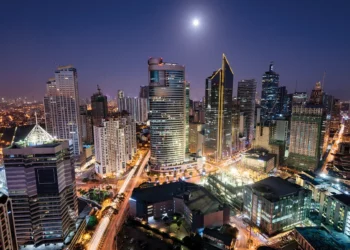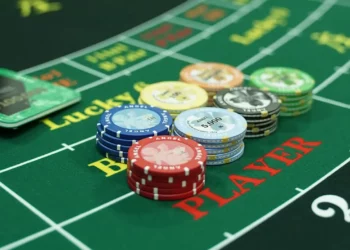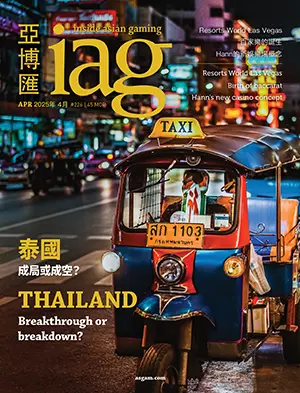A VIP renaissance, a booming mass market— what’s not to like in this most auspicious of Chinese New Years?
The ancient Chinese believed a snake in the house was a portent of good things—it meant the family would not starve.
Whether you believe that or not, what’s for sure here in Macau on the eve of the uncoiling of the “Year of the Snake” is that no one connected with the world’s largest casino market will be going hungry.
Forecasts out of the gate are bullish. Analysts are talking about anywhere from 10% (Citigroup) to 18% (J.P. Morgan) growth coming off a 2012 in which the industry racked up MOP304.14 billion in gross gaming revenue (US$38 billion), surpassing a banner 2011 and handily at +13.5%.
While this was well off the 26% average of the previous five years, no one is complaining, given the challenging environment economically and politically that prevailed in China through most of 2012 which contributed to making it the worst year for VIP revenue growth (+7.5%) since the 2008-09 global financial crisis. What it implies is a market that will be about US$4 billion to $7 billion larger than it was in 2012 and more profitable by upwards of $1 billion or more, taking last year’s mean EBITDA margin of 22% as a benchmark, with the obvious caveat that operating leverage tends to vary widely from operator to operator and casino to casino depending on business model, revenue mix and other factors.
Expectations of a recovery in the VIP sector, which still drives better than two thirds of revenues, 68% of GGR in 2012, figure prominently in everyone’s crystal ball. And given the close correlation historically between growth in the rolling chip segment and the macroeconomics of mainland China, and particularly of neighboring Guangdong Province, it augurs well for 2013 that experts are confident more or less that the world’s second-largest economy is bouncing back from successive years of relatively sluggish growth. China GDP fell from a 10.4% increase in 2010 to 9.3% in 2011 to the weakest pace in 13 years in 2012 at 7.8%. But exports are expected to recover this year on signs that demand is on the mend in Europe and the United States, and this, coupled with looser monetary policy, increased government spending and rising domestic demand, will drive growth this year in the range of 8.4%-8.6%, according to recent estimates by China’s Bank of Communications, the World Bank and HSBC.
The economy beat expectations in the fourth quarter, growing by 7.9% and reversing seven consecutive quarters of slowdowns. Not surprisingly, VIP revenue returned to the black after a 1% decline in Q3, which happened to be the first quarterly contraction in three years and coincided with the worst three months for GDP growth since 2009. Rolling chip turnover was up 6.8% in Q4, and the sector took in MOP54.7 billion ($6.83 billion), its best three revenue months in absolute terms ever, capped by a December that saw revenue jump 16% year on year on an 8.8% increase in turnover.
“Macau VIP gaming revenue normally lags the macro indicators such as money supply, PMI [purchasing managers index, a gauge of manufacturing sector health] and Guangdong export growth by around three to four months,” notes Kenneth Fong, who covers gaming for J.P. Morgan out of Hong Kong. “Over the past few months, we have gradually seen all these macro indicators improve. When this is coupled with the gradual recovery of the global economy, these factors could collectively lead to an improvement of external demand, and hence exports. This should continue to drive gradual improvement in the VIP segment.”
At Deutsche Bank, analyst Karen Tang believes 2013 “will be marked by the return of the VIPs”.
“Leading indicators such as fine wine prices suggest an imminent recovery in high-end spending,” she says. “Junkets also believe that pent-up VIP demand is about to be released.”
But it’s a tricky business, prognostication, especially when it comes to VIP, built as it is upon the workings of a vast, labyrinthine network of gambling room operators and promoters and junketeers and their partners and agents and sub-agents within China and without: an enormous shadow banking system responsible for more than $6 trillion in rolling chip turnover in 2012 even though individuals can legally take no more than $50,000 out of China in a year. And it’s a volatile trade. It’s credit play that operates on slender margins—8-12%, depending on luck, after tax and the revenue split with the junkets and promoters. And being more demand- than supply-driven, unlike the mass market, it has shown itself more vulnerable than the mass market to perceptions and the influence of external factors such as politics and policy.
Mr Fong, who is probably the most bullish on the sector, acknowledges the difficulty: “One of the reasons why investors refrain from assigning a higher valuation to the Macau gaming sector is its reliance on credit-driven VIP revenue, the growth of which is extremely hard to predict.”

Last year was especially trying in this respect. First, the Bo Xilai scandal hit, with all the talk that followed of a new, harder line on corruption and a closer eye on the billions that are being spirited out of the country every month. Then the second half was consumed with the ascent of a new leadership clique at the top of the all powerful Communist Party, an event that occurs only once every 10 years and naturally is very closely watched.
But perhaps this is too much rearviewmirror gazing. Analysts on the eve of the Year of the Snake were feeling good about the comfort level politically within China and the country’s improving macros and so they’re optimistic about VIP. That said, the range of expected growth, currently 5-15%, depending on who you talk to, is wide enough to leave plenty of room for error.
What inspires them more, what some investors might even find dazzling, are the prospects when you have 35 casinos, probably they will number no more than 40 or 41 over the next five years, operating on the doorstep of a billion Chinese. This is the amazing story that is the Macau mass market. These are the players at the main-floor tables and slot machines who have been generating top-line growth at quarterly averages of 27% or better going back to the end of 2009. Much has been written about them and the way they’re changing the very architecture of industry profitability as the volume of their play grows. This will be the most closely watched of Macau metrics: this fundamental shift in revenues from their historical dependence on a relative handful of super-rich gamblers from the immediate environs of Hong Kong and Guangdong to the tens of millions of urbanized mainlanders working and saving their way to the lineaments of a middle-class lifestyle.
“It’s not that complicated,” says Hong Kong-based analyst Aaron Fischer of CLSA Asia-Pacific Markets, who advises that investors would do well to think about Macau as a big-picture play on China’s prodigious capacity for consumption.
“And if you start thinking about it as a consumer category,” he says, “then you need to understand what’s happening in China, and what’s happening all over Asia, which is very obvious—the middle class expanding massively. We’ve understood how high the appetite to gamble is in Asia, and when you combine that with the massive explosion in wealth, it results in a very large market.”
Estimates of how large vary. In China, “middle class” can be somewhat of a misleading term, at least as it’s understood in the West, because the costs of living are so different. Generally, a household is considered to qualify if one-third of its income is available for discretionary spending. This can take in anywhere from the US dollar equivalent of $6,000 in annual income to $60,000, an enormous band that has ballooned with the quadrupling of urban disposable incomes since the turn of the century. It’s a relatively youthful demographic, too, most of its members under 50 years old, homeowners many of them, aspirational, hopeful about their material prospects, possessed of a desire to see the world—more than 70 million Chinese traveled abroad last year—and eager to indulge a decided taste for luxury brands. A conservative estimate would put their numbers at 25% of the total population, about 325 million people, larger than the entire population of the United States.
With Macau penetrating only about 1.3% of mainland China, the impact of this middle class is proving to far exceed its numbers. Mass-market tables and slots, though they constitute less than one-third of revenues, are driving 50% of earnings, most of it coming in the form of high margin cash play at the public tables at bets in the range of HK$500-$5,000, the bigger bettors comprising the coveted “premium mass” segment. This was the story of 2012, when mass-market GGR, tables and slots combined, soared 32% year on year, and it’s certain to dominate the conversation this year amid growth estimates that range from 20-28%.
“With profit per unit in mass now equal to profit per unit in VIP in the market overall,” the sector will be the “key” to 2013, as analyst Grant Govertsen of Union Gaming Research Macau sees it.
Few, if any, would disagree.
In the fourth quarter, mass-market tables delivered revenue growth of 31% and slots and electronic table games, which the government counts as “slots,” 15% (16% for the year), both well exceeding the 9.9% growth in Q4 for the market as a whole.
This is particularly noteworthy for having been achieved in the absence of a meaningful increase in visitation, which ran basically flat with 2011 at +0.03%, just a little over 28 million. Interestingly, though, Union Gaming believes the official figures may be deceptive. Mr Govertsen says that if you factor out the decline in the number of so-called “transit visitors” (those holding visas for a third-party country) and the effects of last year’s crackdown by the PRC on mainland traders who cross and recross the border transporting goods from Macau for sale—and same-day visits from mainland China were down 6.3% in 2012, if that tells us anything—visitation from the mainland actually may have increased by 14% or more, by at least 2.4 million visitors, while visitation from all markets may have increased by 4%.

Feeder market—neighboring Guangdong Province is the largest source of visitors to Macau.
What is certain is that the quality of the visits continues to improve. The number of overnight stays, a key indicator, rose 10% last year. Data available from the government’s Statistics and Census Service through the third quarter show spending per visitor up an average of 17%. Among mainland Chinese, historically Macau’s biggest spenders, the increase per capita was 19%. Here as well, the impact of the mass market has been telling, given the considerable proportion of mainlanders arriving on the government’s Individual Visit Scheme. Travelers on individual visas tend to be more affluent than the package tour crowd, or so it’s believed, and IVS visits to Macau were up 42% last year, an increase year on year of 8.2%. Neighboring Guangdong Province, the largest source of visitors, also was the largest source of IVS travelers at 67.2%.
Which makes sense, again, when you look at gaming revenue per visitor. This was up 8.8%, even working from UGR’s higher estimate of total visitation. Assuming two thirds of table inventory was public (3,300 tables), average daily revenue per table in the mass market was up a whopping 29% versus 9.2% for the market as a whole and 3% for VIP.
“As the combined high-margin business of mass market tables and slots continues to grow well into the double digits … the revenue mix shift should continue,” says Mr Govertsen, who expects that mass tables and slots will account for 35% of total GGR this year.
Proportionately, that means an industry that will be at least 10% more profitable in 2013 in EBITDA terms than it was in 2012.
Not a bad epitaph for the Year of the Snake.
At current growth rates, looking ahead three to four years, Mr Fong estimates that mass will be contributing a full 75% of earnings.

























